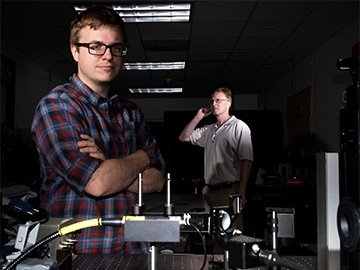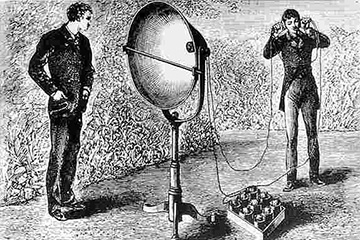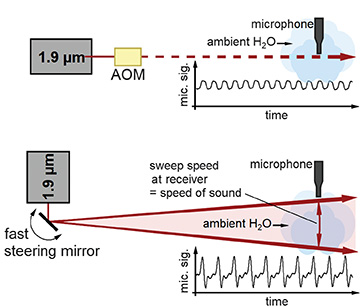
Lead author Ryan Sullenberger and team leader Charles Wynn have developed ways to use laser light, at wavelengths and intensities consistent with eye and skin safety, to transmit a highly targeted audible message to a person without any type of receiver equipment. [Image: MIT Lincoln Laboratory]
Researchers at the Lincoln Laboratory of the Massachusetts Institute of Technology have demonstrated two approaches for beaming sound directly to the ear of a person at a distance—with the acoustic information riding across free space on a near-infrared laser beam (Opt. Lett., doi: 10.1364/OL.44.000622). The techniques rely on the photoacoustic effect, in which light energy is converted into sound after absorption of the optical energy by the surrounding medium (in this case, water vapor in the atmosphere).
Thus far, the system has been tested across only short distances, on the order of several meters. But the researchers believe that the techniques they describe offer opportunities for developing “photoacoustic communications systems capable of delivering audible messages to subjects who lack any communication equipment.” Such capabilities, if realized, could find use in areas ranging from commercial communications to defense and law enforcement.
From “photophone” to laser beam
Practical ideas about transmitting sound via light beams have been around for well over a century. In 1880, for example, Alexander Graham Bell and Charles Sumner Tainter patented a design for a “photophone.” The device worked by using amplitude-modulated sunlight to transmit sound information across a distance to a selenium cell that sat at the focus of a parabolic mirror. That photocell converted the received light signal into modulated electrical impulses that—as with Bell’s more familiar invention, the telephone—could be converted back into acoustic vibrations.

Illustration of the receiver of the “photophone” patented in 1880 by Alexander Graham Bell and Charles Sumner Tainter. [Image: S.P. Thompson, “Notes on the construction of the Photophone,” Phys. Soc. Proc. 4 (1881)/Wikimedia Commons]
Bell and Tainter ultimately succeeded in demonstrating the photophone across an impressive distance of 213 m. The photophone never caught on, however, as it fell prey to the usual banes of free-space optical communications, particularly unreliability and interference in the foggy, cloudy or rainy conditions inevitable on planet Earth. The device also required receiving equipment at the end of the transmission—that is, it could not create a sound directly beamed to a recipient’s ear.
Since the invention of the laser, the free-space optical communication of sound envisioned in Bell’s photophone concept has taken on new life. The U.S. defense establishment, for example, is experimenting with the use of laser-induced plasmas, under which a high-powered laser ionizes the air to create a plasma and plasma-induced sound. But the system’s high laser powers and ionizing radiation, while okay for the battlefield, could prove far too unsafe for use in communicating an audio message directly to an individual recipient.
Atmospheric water vapor as an acoustic speaker
The Lincoln Labs team, led by Charles Wynn, wanted to get past these problems, and arrive at a system that could transmit sound via light through air directly to an individual safely and without the need for an intermediate receiving device. To do so, the researchers took advantage of the fact that ambient water vapor in the air naturally absorbs light energy at certain wavelengths. Under the photoacoustic effect, such absorption of modulated light energy can lead to the production of acoustic waves, or sound.
The team started by selecting, as a light source, a thulium fiber laser from IPG Photonics that operated at a 1.9-μm wavelength. The near-infrared wavelength was a reasonable choice, both for reasons of eye safety and because water vapor strongly absorbs light in that band, offering the prospect of a good acoustic signal. Another constraint was laser power: The system needed to operate at an intensity of 100 mW/cm2 or lower, to avoid thermal damage to eyes or skin.
Continuous-wave and swept-laser approaches

The teams approaches included encoding sound on a 1.9-m infrared laser using an acousto-optic modulator (AOM, top) and a mirror that steered the laser at an angular velocity that, at the distance of the intended receiver, would equate to a linear velocity equal to the speed of sound. [Image: Sullenberger et al., Opt. Lett., doi: 10.1364/OL.44.000622]
Within those constraints, the team tested two setups. One used an acousto-optic modulator (AOM) to encode a sound-based amplitude modulation on the light signal. In this setup, atmospheric absorption and photoacoustic conversion of the modulated light leads to a continuous-wave acoustic signal all along the laser path.
The team’s other approach used a fast-steering mirror to swing the beam back and forth across a short sweep distance. The speed of the mirror is so calibrated that the beam spot would travel at the speed of sound across a short arc in the area of the individual targeted to pick up the acoustic signal. The coherent addition of photoacoustically generated sound at the arc amplifies the acoustic signal, and leads to a pulsed sound emission that can be heard by a recipient without the requirement of any resonant chamber—a sound out of thin air, as it were.
Changing the length of the arc allows the laser sweeps to encode different frequencies, making an AOM unnecessary in this setup. And, as another advantage, the mirror-sweep method allows the system to deliver a message to a single observer at a specific, controllable distance from the source, or to multiple individuals at known distances, without eavesdropping by others in the light path.
Scaling up
The team tested both the AOM and laser-sweep methods across a distance of more than 2.5 m, and found that both could transmit sound—with the AOM method producing a higher-fidelity signal and the laser-sweep method offering a louder, clearer sound.
It is not hard to envision applications for a system that can transmit sound via infrared laser to specific individuals unequipped with receiving devices—for instance, communication to first responders (or potential victims) in security, active-shooter or disaster situations. The researchers are now working to scale the system up across longer standoff distances, with an eye toward eventual commercialization.
